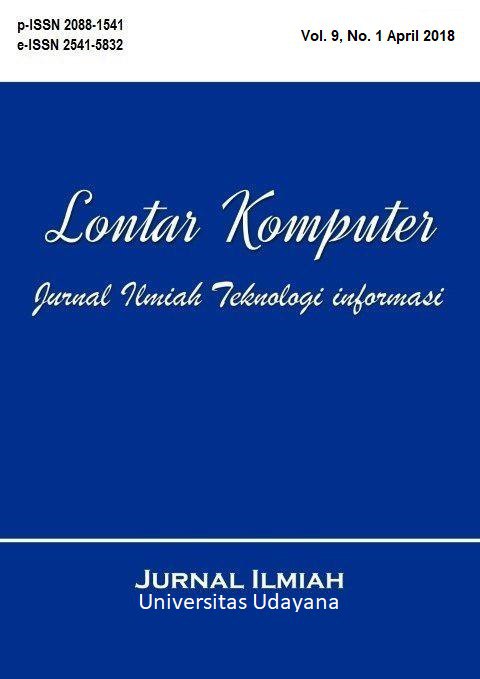Poisonous Shrimp Detection System for Litopenaeus Vannamei using k-Nearest Neighbor Method
Abstract
One of the important seafoods in the food consumption of humans is shrimp. Although shrimp contains proteins that are needed by the human body, sometimes it contains toxins. This is due to environmental factors or catching processes that may use toxins. Therefore, the community should take precautions when consuming shrimp. White shrimp (Litopenaeus vannamei) is one type of shrimp that is preferred because of its delicious taste. The purpose of this research is to develop a computerized system for poisonous white shrimp detection. The category of white shrimps consists of two kinds, i.e., fresh white shrimps that are caught in a natural way (class A), and poisonous white shrimps that are caught by using toxin (class B). The features used are RGB colors (red, green, and blue) and texture (energy, contrast, correlation, and homogeneity). A similarity-based classification is performed by the k-Nearest Neighbor (k-NN) algorithm. The experiment was conducted on a dataset consisting of 90 white shrimp images. The holdout validation method was used to evaluate the system. The original dataset was divided into two parts, whereby 60 images were used as training samples and 30 images were used as testing images. Based on the evaluation results, it can be concluded that the classification accuracy is 73.33%. The benefit of the developed system is to help the community in selecting good and safe white shrimps.
Downloads
References
[2] M. Prashanth and C. Indranil, “Journal of Medical and Health Sciences Food Poisoning : Illness Ranges from Relatively Mild Through To Life Threatening,” Journal of Medical and Health Sciences Food, vol. 5, no. 4, pp. 1–19, 2016.
[3] Abdullah, Usman, and M. Efendi, “Sistem Klasifikasi Kualitas Kopra berdasarkan Warna dan tekstur Menggunakan Metode Nearest Classifier (NMC),” Jurnal Teknologi Informasi dan Ilmu Komputer (JTIIK), vol. 4, no. 4, pp. 297–303, 2017.
[4] S. Zhang, X. Li, M. Zong, X. Zhu, and R. Wang, “Efficient kNN Classification With Different Numbers of Nearest Neighbors,” IEEE Transactions on Neural Networks and Learning Systems, pp. 1–12, 2017.
[5] P. Galdi and R. Tagliaferri, “Data Mining: Accuracy and Error Measures for Classification and Prediction,” in Reference Module in Life Sciences, no. January, Elsevier, 2018, pp. 1–14.
[6] J. M. Kirimi and C. A. Moturi, “Application of Data Mining Classification in Employee Performance Prediction,” International Journal of Computer Applications, vol. 146, no. 7, pp. 28–35, 2016.
[7] N. C. S. Reddy, K. S. Prasad, and A. Mounika, “Classification Algorithms on Datamining : A Study,” International Journal of Computer Intelligence Research, vol. 13, no. 8, pp. 2135–2142, 2017.
[8] P. Sagar, Prinima, and Indu, “Analysis of Prediction Techniques based on Classification and Regression,” International Journal of Computer Applications, vol. 163, no. 7, pp. 47–51, 2017.
[9] M. Kibanov, M. Becker, J. Mueller, M. Atzmueller, A. Hotho, and G. Stumme, “Adaptive kNN using Expected Accuracy for Classification of Geo-Spatial Data,” in Proceedings of Symposium on Applied Computing (SAC), 2017, pp. 1–9.
[10] E. López-Iñesta, F. Grimaldo, and M. Arevalillo-Herráez, “Classification similarity learning using feature-based and distance-based representations: A comparative study,” Applied Artificial Intelligence, vol. 29, no. 5, pp. 445–458, 2015.
The Authors submitting a manuscript do so on the understanding that if accepted for publication, the copyright of the article shall be assigned to Jurnal Lontar Komputer as the publisher of the journal. Copyright encompasses exclusive rights to reproduce and deliver the article in all forms and media, as well as translations. The reproduction of any part of this journal (printed or online) will be allowed only with written permission from Jurnal Lontar Komputer. The Editorial Board of Jurnal Lontar Komputer makes every effort to ensure that no wrong or misleading data, opinions, or statements be published in the journal.
 This work is licensed under a Creative Commons Attribution 4.0 International License.
This work is licensed under a Creative Commons Attribution 4.0 International License.























